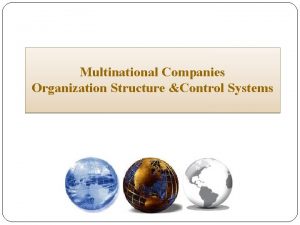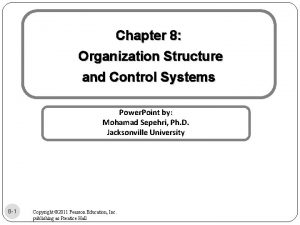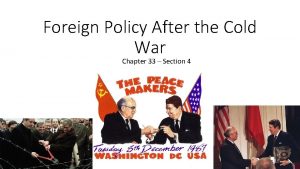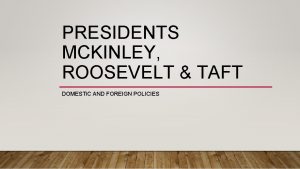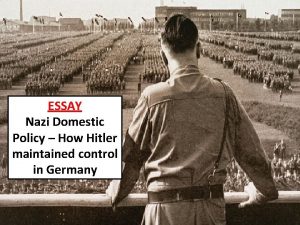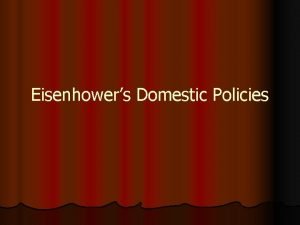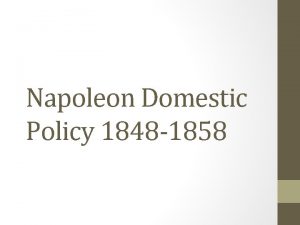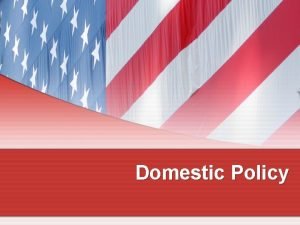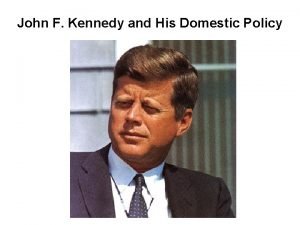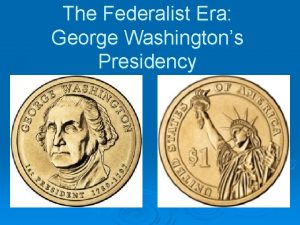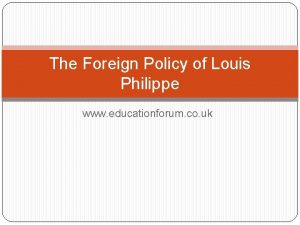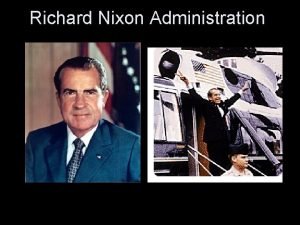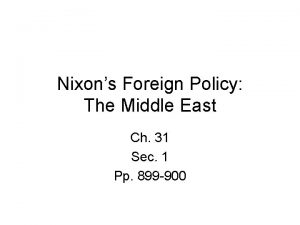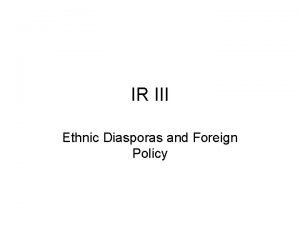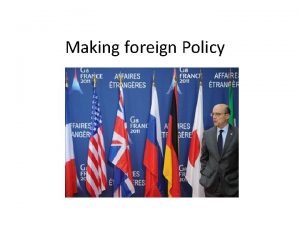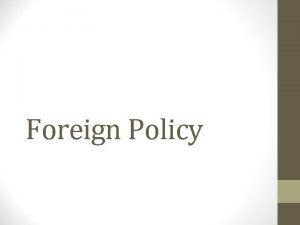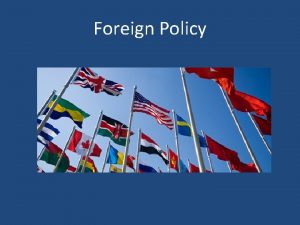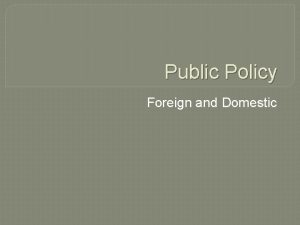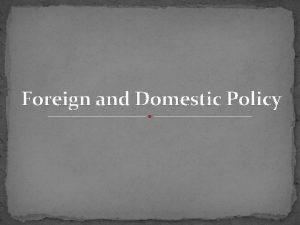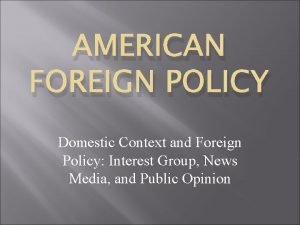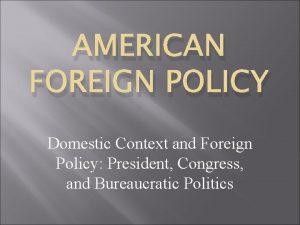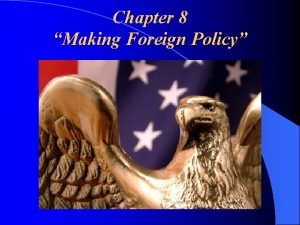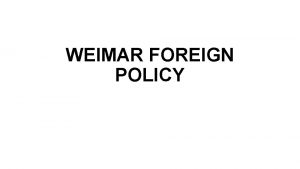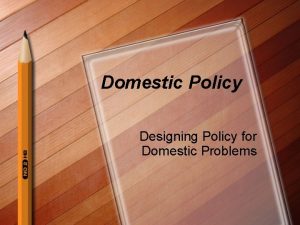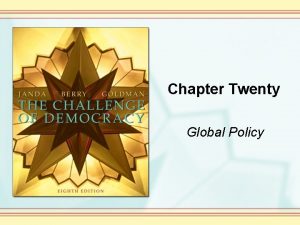Domestic and Foreign Policy Chapter 14 CHAPTER 14



















- Slides: 19

Domestic and Foreign Policy Chapter 14 CHAPTER 14: DOMESTIC AND FOREIGN POLICY

In this chapter, you will: • Trace the five stages of public policymaking • Review the history of US social policy with attention to “entitlement programs • Learn how the federal budget process drives much of our policymaking • The three goals of American foreign policy: security, prosperity, and spreading American value • Who makes foreign policy and how • Broadly view American foreign policy over the past hundred years CHAPTER 14: DOMESTIC AND FOREIGN POLICY

Public Policy Making in Five (not-so-easy) Stages • U. S. policymaking involves five stages. Policies do not proceed neatly from one to the next, but the “stages” idea is a useful way of distinguishing among different actions carried out by policy officials. • The first of these stages is agenda setting, whereby concerns receiving widespread attention become policy issues. CHAPTER 14: DOMESTIC AND FOREIGN POLICY

Public Policy Making in Five (not-so-easy) Stages • A second stage is problem definition and framing, featuring debates about how to describe an issue and which solutions are most viable. • A third stage is policy formation, a process of legislative and executive activity to develop the policy idea in concrete terms. • A fourth stage is policy implementation, marked by rulemaking and service delivery. • A fifth stage includes evaluation and policy feedback, steps that help determine whether a policy works—and that often start debates all over again. CHAPTER 14: DOMESTIC AND FOREIGN POLICY

U. S. Social Policy • Social policymaking in the United States is typically more controversial, and features less expansive coverage, than social policymaking in other advanced industrial nations. • Wars, along with severe economic downturns, have been major sources of expansions in American social policies across U. S. history. • Three large social programs—Social Security, unemployment insurance; and Medicare/Medicaid—are especially significant in U. S. government. CHAPTER 14: DOMESTIC AND FOREIGN POLICY

Economic Policymaking Fiscal and Monetary Policy • The U. S. government employs both fiscal policy and monetary policy to affect the economy. • Taxes and spending are the chief levers of fiscal policy. During economic downturns, Republicans prefer to enact tax cuts; Democrats favor spending programs. • The Federal Reserve is the main architect of monetary policy. By adjusting interest rates and the national supply of money, the Fed works to affect inflation and unemployment. CHAPTER 14: DOMESTIC AND FOREIGN POLICY

Economic Policymaking The Federal Budget Process • The U. S. budget process, when on schedule, runs from early February through October 1 and encompasses a presidential proposal, a concurrent budget resolution, and appropriations bills. • In practice, the process rarely runs on time, and various “fixes” like omnibus bills and continuing resolutions keep the budget system functioning. • Although the details can be obscure, budget battles in Washington are among the most dramatic features of U. S. policymaking because of the high stakes involved. CHAPTER 14: DOMESTIC AND FOREIGN POLICY

Foreign Policy • Two leading foreign-policy views, realism and liberalism, differ sharply on how best to ensure security for Americans and allied countries. • To pursue the first goal of American foreign policy, security, realists urge the United States deploys a large military and maintains a policy of primacy. • Liberal thinkers prefer diplomacy and other forms of multinational cooperation, soft (or cultural) power, and foreign aid. CHAPTER 14: DOMESTIC AND FOREIGN POLICY

Foreign Policy • A second goal of foreign policy is to protect prosperity. Economic strength is the ultimate source of power on the world stage. • Today, the U. S. economy is the largest in the world, but many Americans and allies around the globe wonder: Will the United States maintain its economic strength relative to other nations? CHAPTER 14: DOMESTIC AND FOREIGN POLICY

Foreign Policy • American economic policy has been guided by pursuit of free trade—the dropping of barriers to international commerce. Resistance has grown to free trade, among President Trump and allies as well as congressional Democrats. Many support fair trade. • The United States tries to spread its own values of democracy and freedom—a third foreign-policy goal. CHAPTER 14: DOMESTIC AND FOREIGN POLICY

Who Makes Foreign Policy? • Many different individuals and institutions shape foreign policy. • Congress and the White House were originally foreign-policy partners. During the Cold War, checks and balances diminished. Today, the president takes the lead and Congress offers a check. CHAPTER 14: DOMESTIC AND FOREIGN POLICY

Who Makes Foreign Policy? • The most important executive agencies in foreign policymaking are the State Department, the Defense Department, and the National Security Council. • Other important foreign-policy influences include intelligence agencies such as the CIA, economic bureaus, interest groups, corporations, foreign governments, the media, and the public. • Is the messy, fragmented system swirling around the president an effective way to generate new ideas? Or is it too chaotic for the twenty-first century? Or both? CHAPTER 14: DOMESTIC AND FOREIGN POLICY

Grand Strategies in U. S. History • The United States forged four grand strategies in the twentieth century: It stood alone and acted unilaterally (1918– 1939), it led the democratic nations in multilateral coalitions during the Cold War (1945– 1991), it debated a new world order after the Cold War (1991– 2001), and it launched a war on terror (2001– 2009). CHAPTER 14: DOMESTIC AND FOREIGN POLICY

Chapter Summary • Public policymaking involves choices: Should we launch a manned mission to Mars? Open formerly protected lands to oil and gas drilling? Pull out of the NAFTA treaty? Understanding those choices is the essence of politics and government in America. • Five stages, from agenda setting through evaluation, mark the process of domestic policymaking. These are not a blueprint for action, but most policy achievements pass through all five. CHAPTER 14: DOMESTIC AND FOREIGN POLICY

Chapter Summary • The largest U. S. programs are social policies such as Social Security, Medicare, Medicaid, and unemployment insurance. Long time American resistance to big government helps to explain their slow growth. • Heightened attention to fiscal and monetary policy, combined with harder economic times, has elevated the importance of budgeting in American politics. The federal budget process is a complicated machine which rarely meets its key deadlines—largely because the financial stakes are so high. CHAPTER 14: DOMESTIC AND FOREIGN POLICY

Chapter Summary • Foreign policy explores how the United States engages the world. Is the United States the richest and most powerful country, still the global leader, or is it a declining superpower? • The three goals of American foreign policy are security, prosperity, and spreading American values. These three goals sometimes conflict. CHAPTER 14: DOMESTIC AND FOREIGN POLICY

Chapter Summary • The United States spends as much on its military as do other leading powers combined. Primacy suggests that it should act with unparalleled power. The security trap suggests that an effort to maintain primacy builds resentments and resistance. Soft power leads instead through culture and values. • American policymakers must make two basic choices: isolationism versus active engagement with the world; unilateralism (going it alone) and multilateralism (working with other nations in organizations and associations). CHAPTER 14: DOMESTIC AND FOREIGN POLICY

Chapter Summary • The United States is responsible for a fifth of the world economy, nearly 50 percent more than its nearest rival, China. However, China’s economic growth rate in recent years has been much higher than that of the United States. • U. S. economic policy long revolved around free trade— reducing barriers to trade between nations. Today, free trade meets resistance. CHAPTER 14: DOMESTIC AND FOREIGN POLICY

Chapter Summary • Prime responsibility foreign policy has shifted from Congress to the executive. However, foreign policy is the outcome of many agencies and groups pushing for their own interests and advantage. • Twentieth-century grand strategies included isolationism (1918– 1939), World War II, the Cold War, and internationalism (1942– 1989), the search for a new world order (1991– 2001), and the war on terror (since 2001). CHAPTER 14: DOMESTIC AND FOREIGN POLICY
 Mnc organizational structure
Mnc organizational structure Domestic structure plus foreign subsidiary
Domestic structure plus foreign subsidiary Too foreign for home
Too foreign for home Chapter 33 section 4 foreign policy after the cold war
Chapter 33 section 4 foreign policy after the cold war William h taft domestic policy
William h taft domestic policy Domestic policy of hitler
Domestic policy of hitler Eisenhower domestic policies
Eisenhower domestic policies Napoleon bonaparte domestic policies
Napoleon bonaparte domestic policies What is domestic policy
What is domestic policy Thomas jefferson domestic policy
Thomas jefferson domestic policy Queen hatshepsut domestic policy
Queen hatshepsut domestic policy Kennedy's domestic program
Kennedy's domestic program Domestic policy
Domestic policy George washingtons domestic policy
George washingtons domestic policy 1790 foreign policy
1790 foreign policy Foreign policy of louis philippe
Foreign policy of louis philippe What was thomas jefferson foreign policy
What was thomas jefferson foreign policy Nixons foreign policy
Nixons foreign policy Nixons foreign policy
Nixons foreign policy Actors in foreign policy
Actors in foreign policy
